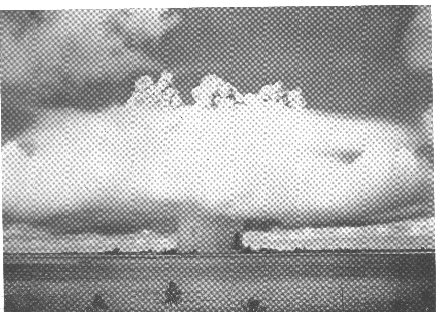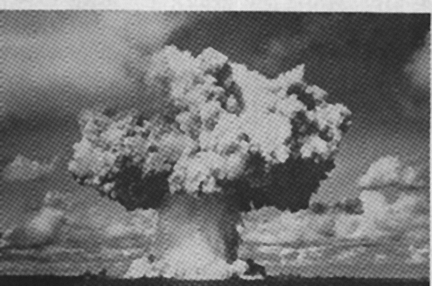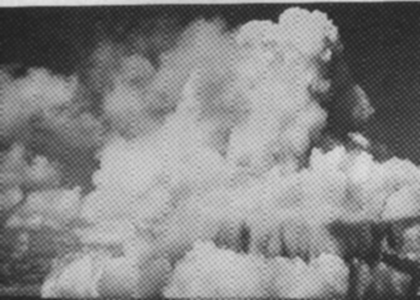OPERATION CROSSROADS
Operation Crossroads was the code name given to experiments
on the military use of atomic bombs by the United States in 1946 at Bikini
Atoll in the Pacific Ocean.
In July of that year, the U.S. Army and Navy detonated two nuclear bombs in
Bikini Atoll lagoon -- one above water and one under
water to test the effects of a nuclear attack on a naval fleet. The fleet
consisted of expendable ships of the U.S. Navy, and
ships from captured German and Japanese fleets, including
battleships, cruisers, an aircraft carrier, and submarines. The Army contended
that the atomic bomb made naval fleets obsolete, whereas the Navy did
not think so.
The above water
atomic bomb test had the code name of Able, which was carried out on July 1,
1946. A few ships sank or were physically damaged by the force of the blast,
and many caught fire. The Navy said that too few ships sunk to consider that
atomic bombs could sink a fleet.
The second test, code name Baker, consisted of an atomic bomb detonated
beneath the water of the lagoon. The test was held on July 25. Some ships were
swamped and sank outright, but many appeared unharmed and the Navy
claimed that most ships remained unharmed. However, radioactive
tests of all the ships showed that the radioactive mist that surged
across the lagoon completely drenched most most of the ships
and they were too dangerous for use. It showed that underwater atomic blasts
can make a fleet too radioactive to be operational.
The atomic bomb was placed in a canister suspended at about 40 meters depth
from a Navy boat and detonated by a radio impulse at 8:35 in the morning.
The bomb's energy yield was 23,000 tons of TNT, the same as the bomb that
was dropped on Nagasaki, Japan, on August 9, 1945.
The underwater shock wave spread throughout the lagoon at 3,500 mph as a shock
disk clearly visible in aerial photographs. The fireball bubble reached
the surface of the lagoon within a few milliseconds.
As the steam and fission products hit the atmosphere, a
huge dome-shaped condensation cloud flashed into view, shooting upward at
3.2 km per second. The dome was lit from within by the explosion and burst
in another hundreth of a millisecond. 400 million kilograms of water
were ejected as a hollow column about a kilometer in diameter. The
explosion column was made of water droplets and gases mixed as an aerosol.
When the aerosol column collapsed back to the surface of the lagoon, it
created a hurricane-velocity wave called a "base surge."


 As
the explosion column emerged from the lagoon, there was no outward flowing base
surge, but after about 9 seconds, the explosion column began to fall back and
fed the base surge which expanded outward from the base of the column as shown
here. It initially traveled at about 100 km per hour. About 30 seconds after
detonation the base surge had engulfed most of the target ships in Bikini Lagoon
with a radioactive mist that permeated all of the ships from top to bottom,
making them extremely dangerous to personnel and impossible to use safely.
As
the explosion column emerged from the lagoon, there was no outward flowing base
surge, but after about 9 seconds, the explosion column began to fall back and
fed the base surge which expanded outward from the base of the column as shown
here. It initially traveled at about 100 km per hour. About 30 seconds after
detonation the base surge had engulfed most of the target ships in Bikini Lagoon
with a radioactive mist that permeated all of the ships from top to bottom,
making them extremely dangerous to personnel and impossible to use safely.
In 1962, the U.S. government exploded a 100 kiloton atomic bomb
called "Sedan" at shallow depth (194 meters) in alluvial deposits at
the Nevada Test Site. The explosion excavated a crater 370 meters
in diameter and 98 meters deep. The fallback of its
explosion column produced a base surge with an initial velocity of
over 50 meters per second that spread across the
desert floor. The Sedan base surge was a mixture of gases from the
atomic explosion mixed with dust and sand of the alluvium from the
desert floor.
The Bikini and Sedan tests were non-volcanic, but the process of an
explosion column collapsing to
produce a turbulent flowing cloud across the surface of water or land
was reproduced by Taal Volcano in the Philippines during its 1965-1966
eruption, which led to the study of volcanic base surge deposits at other
volcanoes around the world.
The discovery of the base surge at Bikini had a
great impact on research concerning maar volcanoes and the effects of
mixing water with magma. These avenues of research led to a better
understanding of volcanic hazards, including pyroclastic flows, which in
turn have helped save people living near erupting volcanoes. However, were the revelations about the base surge worth the dangers of radioactivity for the 42,000 sailors and soldiers? About one-half of the personnel at Bikini have died, a death rate that excedes the average population death rate. For further information about the atom bomb and the military experience, read
Killing Our Own and see
photos and veterans statements of Operations Crossroads.
Alice A. Parson has recently published a book titled "Bikini Diary: Proud to be Chosen." It tells of Ed Alton, an Atomic Veteran of Operation Crossroads, who kept a dairy of his adventures at Bikini, and his untimely death. Write to Alice A. Parson, 7436 West Main Street, Dothan, Alabama
36305 for information on purchasing the book.
Copyright (C) 1999, by Richard V.
Fisher. All rights reserved.


 As
the explosion column emerged from the lagoon, there was no outward flowing base
surge, but after about 9 seconds, the explosion column began to fall back and
fed the base surge which expanded outward from the base of the column as shown
here. It initially traveled at about 100 km per hour. About 30 seconds after
detonation the base surge had engulfed most of the target ships in Bikini Lagoon
with a radioactive mist that permeated all of the ships from top to bottom,
making them extremely dangerous to personnel and impossible to use safely.
As
the explosion column emerged from the lagoon, there was no outward flowing base
surge, but after about 9 seconds, the explosion column began to fall back and
fed the base surge which expanded outward from the base of the column as shown
here. It initially traveled at about 100 km per hour. About 30 seconds after
detonation the base surge had engulfed most of the target ships in Bikini Lagoon
with a radioactive mist that permeated all of the ships from top to bottom,
making them extremely dangerous to personnel and impossible to use safely.